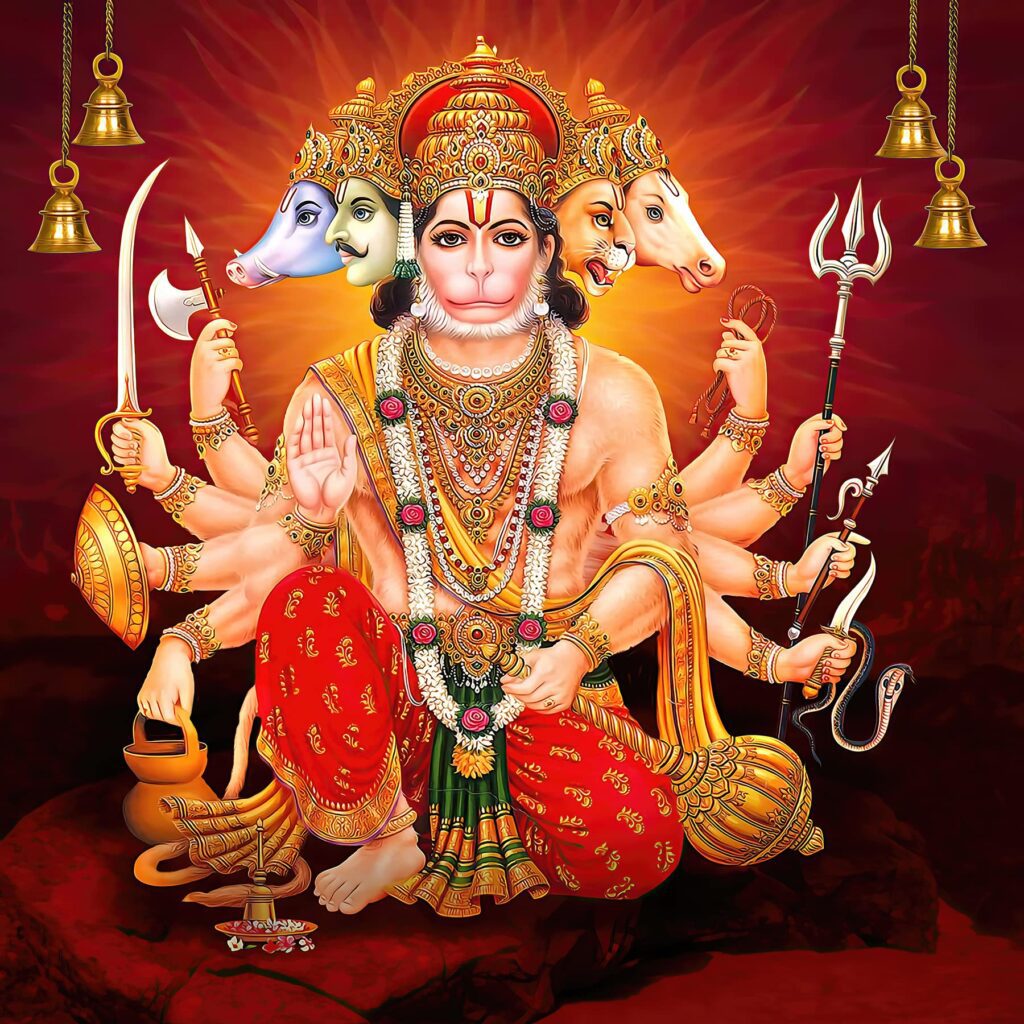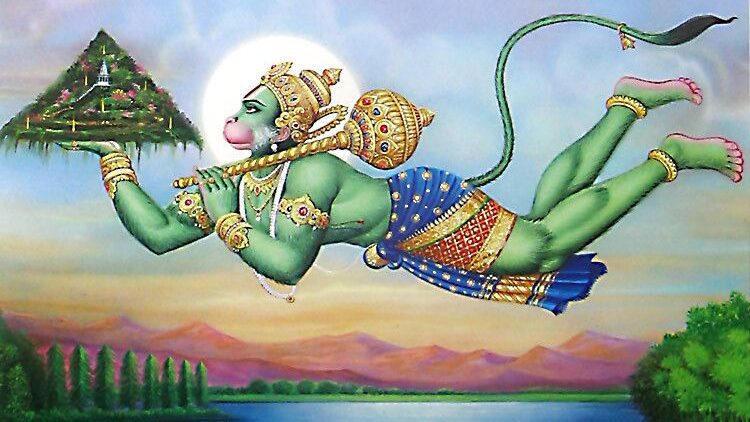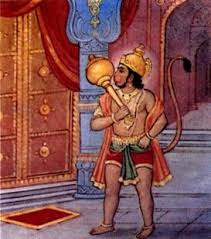Hanuman Chalisa, composed by the revered saint and poet Goswami Tulsidas Ji, is one of the most cherished hymns in Hinduism. Dedicated to Lord Hanuman, it is a spiritual masterpiece of 40 verses (chalisa), written in the Awadhi dialect. Millions recite it daily, finding strength, devotion, and guidance within its sacred words.
The Hanuman Chalisa was composed by Goswami Tulsidas Ji in the 16th century, inspired by his unparalleled devotion to Lord Rama and Lord Hanuman. It is believed that chanting this divine hymn can remove obstacles, dispel fear, and bring inner peace and strength. Lord Hanuman, the embodiment of devotion, valor, and humility, is glorified throughout this hymn, serving as an ideal for all devotees.

In this post, we will humbly explore the Hanuman Chalisa verse by verse, providing a simple translation and its meaning in English.
Hanuman Chalisa – Opening Invocation
The Hanuman Chalisa begins with two dohas (couplets), offering reverence and seeking blessings:
Shree Guru Charan Saroj Raj, Nij Manu Mukuru Sudhaari |
Barnau Raghubar Bimal Jasu, Jo Daayak Phal Chaari ||
Translation:
“I purify my heart and mind by taking the dust of my Guru’s lotus feet. I now humbly describe the glorious virtues of Lord Rama, which bestow the four fruits of life: Dharma (righteousness), Artha (prosperity), Kama (desires), and Moksha (liberation).”
Buddhiheen Tanu Jaanike, Sumirau Pavan Kumar |
Bal Buddhi Vidya Dehu Mohi, Harahu Kalesh Vikar ||
Translation:
“Knowing my intellect to be limited, I meditate upon you, O Hanuman, the son of the Wind God. Bless me with strength, wisdom, and knowledge, and remove my afflictions and impurities.”
Meaning:
Tulsidas Ji begins with humility, acknowledging his dependence on the Guru’s blessings and Lord Hanuman’s grace. He seeks strength and wisdom, setting an example of devotion and surrender.

1. Jai Hanuman Gyan Guna Sagar |
Jai Kapis Tihun Lok Ujagar ||
Translation:
“Victory to Hanuman, the ocean of knowledge and virtues! Victory to the leader of the Vanaras, who brings light to the three worlds.”
Meaning:
Tulsidas Ji begins by praising Hanuman as the embodiment of knowledge, wisdom, and goodness, whose influence extends across the earthly, heavenly, and nether realms.
2. Ramdoot Atulit Bal Dhama |
Anjani Putra Pavan Sut Nama ||
Translation:
“You are the messenger of Lord Rama, the abode of unmatched strength. You are the son of Mata Anjani and are also known as the son of the Wind God.”
Meaning:
This verse highlights Lord Hanuman’s divine lineage and unparalleled physical and spiritual strength. His life is intricately connected to his service to Lord Rama.
3. Mahavir Vikram Bajrangi |
Kumati Nivaar Sumati Ke Sangi ||
Translation:
“O mighty warrior, brave and valiant as lightning! You dispel evil thoughts and are a companion of good intellect.”
Explanation:
Hanuman Ji is revered as Mahavir (the great hero) and is likened to a thunderbolt (Vajrangi) for his strength and courage. He is a guide who removes ignorance and negativity (kumati) from devotees’ minds and fills them with wisdom and virtuous thoughts (sumati).
4. Kanchan Baran Biraaj Subesa |
Kanan Kundal Kunchit Kesa ||
Translation:
“Your golden complexion radiates beauty, and you are adorned with earrings and curly hair.”
Explanation:
Here, Tulsidas Ji describes Hanuman Ji’s divine appearance. His golden complexion symbolizes purity and spiritual brilliance. The mention of his ornaments and curly hair adds a vivid and majestic image of the Lord in the minds of the devotees.
5. Hath Vajra Aur Dhuvaje Viraje |
Kaandhe Moonj Janeu Saaje ||
Translation:
“You carry a thunderbolt and a banner in your hands, and a sacred thread adorns your shoulder.”
Explanation:
Hanuman Ji is depicted holding a thunderbolt (vajra), a symbol of unshakable strength, and a flag representing victory and righteousness. The sacred thread (janeu) on his shoulder signifies his adherence to dharma and his divine status as a selfless servant of the Lord.
6. Shankar Suvan Kesari Nandan |
Tej Pratap Maha Jag Bandan ||
Translation:
“You are the incarnation of Lord Shiva and the son of Kesari. Your radiance and glory are revered by the entire world.”
Explanation:
Tulsidas Ji identifies Hanuman Ji as an incarnation of Lord Shiva, born to Kesari and Mata Anjani. His divine energy and heroic deeds command the respect and reverence of all beings across the three realms.
7. Vidyavaan Guni Ati Chatur |
Ram Kaj Karibe Ko Atur ||
Translation:
“You are immensely knowledgeable, virtuous, and supremely intelligent. You are always eager to serve Lord Rama.”
Explanation:
Hanuman Ji’s intellectual brilliance and noble qualities are unmatched. His life is dedicated to serving Lord Rama, and he eagerly fulfills every task with devotion and enthusiasm.
8. Prabhu Charitra Sunibe Ko Rasiya |
Ram Lakhan Sita Man Basiya ||
Translation:
“You delight in listening to Lord Rama’s glories. You dwell in the hearts of Lord Rama, Lakshmana, and Sita.”
Explanation:
Hanuman Ji finds joy in hearing and singing the divine stories of Lord Rama. His devotion is so pure that he resides in the hearts of Lord Rama, Mata Sita, and Lakshmana, symbolizing his eternal closeness to the divine.
9. Sukshma Roop Dhari Siyahin Dikhava |
Vikat Roop Dhari Lank Jarava ||
Translation:
“In a humble form, you appeared before Sita Mata. In a fierce form, you burned down Lanka.”
Explanation:
Hanuman Ji’s ability to assume various forms demonstrates his versatility and devotion. He adopted a gentle, humble form to console Sita Mata in Lanka and a ferocious form to destroy the demon city, proving his unwavering commitment to Lord Rama’s cause.
10. Bhima Roop Dhari Asur Sanhare |
Ramachandra Ke Kaaj Sanvare ||
Translation:
“Taking on a colossal form, you destroyed demons and completed Lord Rama’s tasks.”
Explanation:
Hanuman Ji’s mighty and imposing form struck terror into the hearts of evil forces. He annihilated demons and ensured the success of Lord Rama’s mission, displaying his unmatched strength and dedication.

11. Laaye Sajivan Lakhan Jiyaye |
Shri Raghubir Harashi Ur Laaye ||
Translation:
“You brought the Sanjivani herb and revived Lakshmana. Lord Rama, overjoyed, embraced you.”
Meaning:
This verse recalls the iconic moment during the Ramayana when Hanuman rescued Lakshmana by bringing the life-saving Sanjivani herb, showcasing his devotion and courage. Lord Rama’s loving embrace symbolizes his appreciation of Hanuman’s selfless service.
12. Raghupati Kinhi Bahut Badaai |
Tum Mama Priya Bharat Hi Samaai ||
Translation:
“Lord Rama praised you immensely, declaring you as dear to him as his brother Bharat.”
Explanation:
In this verse, Tulsidas Ji emphasizes the depth of Lord Rama’s affection for Hanuman Ji. Comparing him to Bharat, Lord Rama’s beloved brother, signifies the ultimate acknowledgment of Hanuman Ji’s devotion and loyalty.
13. Sahas Badan Tumharo Jas Gaavai |
Asa-Kahi Shripati Kanth Lagaavai ||
Translation:
“Lord Vishnu himself declared that a thousand mouths would not suffice to sing your glories, and then he embraced you.”
Explanation:
Hanuman Ji’s virtues are so infinite that even Lord Vishnu acknowledged they are beyond full expression. This verse underscores the divinity of Hanuman Ji’s character and his irreplaceable contribution to Lord Rama’s mission.
14. Sankadik Brahmadi Muneesa |
Narad Sarad Sahit Aheesa ||
Translation:
“The sages Sanaka and others, Brahma, Narada, Saraswati, and Sheshnag sing your praises.”
Explanation:
Hanuman Ji is venerated not only by humans but also by celestial beings and divine entities. The great sages, the Creator Brahma, the celestial musician Narada, the Goddess of Wisdom Saraswati, and the cosmic serpent Sheshnag all celebrate his virtues and devotion.
15. Yam Kuber Digpal Jahan Te |
Kavi Kovid Kahin Sake Kahan Te ||
Translation:
“Even Yamraj (the god of death), Kuber (the god of wealth), and the guardians of the directions cannot fully describe your greatness. How, then, can poets and scholars?”
Explanation:
This verse highlights Hanuman Ji’s immeasurable glory. If even divine beings fail to encapsulate his greatness, mortal poets and scholars, with their limited intellect, can only marvel at his divine deeds.
16. Tum Upkar Sugreevahin Keenha |
Ram Milaya Rajpad Deenha ||
Translation:
“You did a great favor to Sugriva by introducing him to Lord Rama, which led to his restoration as king.”
Explanation:
Hanuman Ji played a crucial role in uniting Sugriva, the exiled monkey king, with Lord Rama. This meeting resulted in Sugriva’s eventual coronation and the alliance between Rama and the Vanaras, pivotal for the battle against Ravana.
17. Tumharo Mantra Vibheeshan Maana |
Lankeshwar Bhaye Sab Jag Jaana ||
Translation:
“Vibhishana heeded your advice and became the king of Lanka, as the world knows.”
Explanation:
Hanuman Ji’s wisdom and guidance transformed Vibhishana, Ravana’s brother, into a devoted ally of Lord Rama. With Hanuman Ji’s support, Vibhishana was crowned the righteous king of Lanka after Ravana’s downfall.
18. Yug Sahasra Yojan Par Bhaanu |
Leelyo Taahi Madhur Phal Jaanu ||
Translation:
“You leaped across thousands of yojanas to the sun, thinking it to be a sweet fruit.”
Explanation:
This verse refers to Hanuman Ji’s childhood when, mistaking the sun for a ripe fruit, he attempted to swallow it. This playful yet awe-inspiring act highlights his immense power and divine origins, even as a child.
19. Prabhu Mudrika Meli Mukha Maahi |
Jaladhi Langhi Gaye Achraj Naahi ||
Translation:
“With Lord Rama’s ring in your mouth, you crossed the ocean effortlessly. This was no surprise for one of your strength and devotion.”
Explanation:
Hanuman Ji’s legendary leap across the ocean to reach Lanka, carrying Lord Rama’s ring as a token for Sita Mata, demonstrates his dedication and courage. His unwavering faith made the seemingly impossible task effortless.
20. Durgam Kaaj Jagat Ke Jeete |
Sugam Anugrah Tumhare Te Te ||
Translation:
“Tasks that are insurmountable for others become simple and achievable by your grace.”
Explanation:
Hanuman Ji’s blessings empower devotees to overcome life’s greatest challenges. His divine assistance transforms the impossible into possible, filling devotees with courage and determination.

21. Ram Dware Tum Rakhware |
Hoat Na Aagya Bin Paisare ||
Translation:
“You are the guardian at Lord Rama’s door, and no one can enter without your permission.”
Explanation:
Hanuman Ji is depicted as the gatekeeper to Lord Rama’s blessings. His approval is essential for anyone seeking Lord Rama’s grace. This verse highlights the importance of approaching Hanuman Ji with humility and devotion as a prerequisite for divine blessings.
22. Sab Sukh Lahen Tumhari Sarna |
Tum Rakshak Kahu Ko Darna ||
Translation:
“All joys come to those who seek refuge in you. With you as the protector, there is no need to fear anyone.”
Explanation:
Hanuman Ji offers complete protection and peace to his devotees. Those who surrender to him are freed from fear and anxiety, enjoying a life filled with happiness and security under his divine care.
23. Aapan Tej Samharo Aapai |
Teenhon Lok Hank Te Kanpai ||
Translation:
“You alone control your immense power, and the three worlds tremble at your roar.”
Explanation:
Hanuman Ji’s strength is immeasurable and restrained by his own will. His mighty presence commands respect across all realms—earth, heaven, and the netherworld. This verse underscores his self-discipline and divine authority.
24. Bhoot Pishach Nikat Nahin Aavai |
Mahavir Jab Naam Sunavai ||
Translation:
“Evil spirits and negative energies cannot approach where the mighty name of Hanuman is chanted.”
Explanation:
Hanuman Ji’s name acts as a divine shield, warding off all evil entities. His name fills the environment with spiritual energy, driving away negative forces and creating a space of protection and peace.
25. Naase Rog Harai Sab Peera |
Japata Nirantar Hanumat Beera ||
Translation:
“Chanting Hanuman’s name constantly removes diseases and relieves all pain.”
Explanation:
Hanuman Ji’s blessings bring healing and relief from suffering. By meditating on his name, devotees experience a transformation in both physical and mental health, underscoring his divine role as a healer.
26. Sankat se Hanuman chudavai |
Man Karam Vachan Dyan Jo Lavai ||
Translation:
“Hanuman frees those from all troubles who focus on him with their mind, actions, and words.”
Explanation:
This verse emphasizes that Hanuman Ji rescues devotees from difficulties when they show complete devotion through their thoughts, deeds, and speech. By meditating on him, acting righteously, and chanting his name, devotees attract his grace and protection, overcoming any obstacles in life.
27. Sab Par Ram Tapasvee Raja |
Tin Ke Kaaj Sakal Tum Saja ||
Translation:
“Lord Rama, the ascetic king, is supreme over all, and you (Hanuman) perfectly carry out all his tasks.”
Explanation:
This verse highlights Hanuman Ji’s unwavering devotion and service to Lord Rama, who is revered as the supreme being and the ideal king. Hanuman Ji’s role as Lord Rama’s most faithful servant is emphasized, as he flawlessly accomplishes every mission entrusted to him. It reminds devotees of Hanuman Ji’s dedication and encourages them to serve with humility and devotion, just as he serves Lord Rama.
28. Aur Manorath Jo Koi Laave |
Soi Amit Jeevan Phal Paave ||
Translation:
“Whoever brings their heartfelt desires to you (Hanuman) receives abundant and everlasting fulfillment.”
Explanation:
This verse conveys Hanuman Ji’s compassionate nature in granting the wishes of his devotees. Those who approach him with sincere devotion and pure intentions are blessed with not only the fulfillment of their desires but also lasting spiritual and worldly rewards. It emphasizes Hanuman Ji’s role as a generous protector and benefactor who ensures the well-being and happiness of his followers.
29. Chaaron Yug Partap Tumhara |
Hai Parsidh Jagat Ujiyara ||
Translation:
“Your glory shines in all four ages, and your fame is spread across the world.”
Explanation:
This verse praises Hanuman Ji’s timeless glory. His power, influence, and divine attributes transcend time and continue to shine through all four Yugas (ages) — Satya Yuga, Treta Yuga, Dwapara Yuga, and Kali Yuga. Hanuman Ji’s fame is not confined to any particular era; it remains eternal, and his name illuminates the world, bringing hope and strength to his devotees across generations.
30. Saadhu Sant Ke Tum Rakhware |
Asur Nikandan Ram Dulaare ||
Translation:
“You are the protector of saints and sages, and the destroyer of demons, beloved of Lord Rama.”
Explanation:
This verse highlights Hanuman Ji’s dual role as a protector and a destroyer. He is the guardian of the righteous—saints and sages—shielding them from harm. At the same time, he is a powerful force against evil, vanquishing demons and negative forces. Hanuman Ji is deeply loved by Lord Rama, and his divine strength is used to uphold righteousness and remove darkness from the world. This verse reflects his unwavering commitment to protecting virtue and eliminating evil.

31. Ashta Sidhi Nav Nidhi Ke Dhata |
Us Var Din Janki Mata ||
Translation:
“You are the giver of the eight siddhis and the nine treasures, as blessed by Mata Sita.”
Explanation:
This verse praises Hanuman Ji as the possessor and bestower of immense spiritual and material powers. The eight siddhis (supernatural powers) and nine nidhi (treasures) are symbolic of the divine wealth and abilities that Hanuman Ji can grant to his devotees. These siddhis include powers like the ability to become small or large, control the elements, and more. The nine treasures refer to wealth, prosperity, and material success. Hanuman Ji’s ability to bestow these blessings comes from his close relationship with Mata Sita, who, along with Lord Rama, blessed him with such divine gifts.
32. Ram Rasayan Tumhare Pasa |
Sadaa Raho Raghupati Ke Dasa ||
Translation:
“The essence of Lord Rama is always with you; may you always remain the servant of Lord Raghupati (Lord Rama).”
Explanation:
This verse praises Hanuman Ji’s deep connection with Lord Rama. It says that the divine essence or “Rama Rasayan” (the sweet, pure essence of Lord Rama’s devotion) always resides with Hanuman Ji, reflecting his unwavering love and loyalty to Lord Rama. Hanuman Ji is forever the devoted servant of Lord Rama, and this verse expresses a prayer that he may continue in this devoted service. It emphasizes the ideal of selfless devotion, where Hanuman Ji’s life is fully dedicated to Lord Rama, and it serves as an inspiration for all devotees to surrender to God with total devotion.
33. Tumhare Bhajan Ram Ko Pavai |
Janam Janam Ke Dukh Bisravai ||
Translation:
“By chanting your praises, one attains Lord Rama, and all the sorrows of many lifetimes are forgotten.”
Explanation:
This verse emphasizes the power of chanting Hanuman Ji’s praises. It states that devotion to Hanuman Ji leads the devotee directly to Lord Rama, as Hanuman Ji is the most devoted servant of Lord Rama. By reciting Hanuman Ji’s name and singing his praises, one not only gets closer to Lord Rama but also experiences liberation from the pains and sorrows accumulated over countless lifetimes. The verse underscores the spiritual significance of Hanuman Ji’s devotion and how it can lead to ultimate peace and connection with the divine.
34. Anth Kaal Raghuvir Pur Jayee |
Jahan Janam Hari-Bakht Kahayee ||
Translation:
“At the time of death, one who remembers Lord Raghuvir (Lord Rama) reaches his divine abode, and in the next life, they are born as a devotee of Lord Hari (Lord Rama).”
Explanation:
This verse assures that a devotee who remembers Lord Rama with sincere devotion at the time of their death is blessed with the eternal reward of reaching Lord Rama’s divine realm. Furthermore, in their next life, they will be born as a true devotee of Lord Rama, signifying the cycle of continuous devotion and divine protection. This verse highlights the significance of unwavering faith in Lord Rama, especially during life’s final moments, ensuring a blessed afterlife and future rebirth as a devoted soul.
35. Aur Devta Chit Na Dharehi |
Hanumanth Se Hi Sarve Sukh Karehi ||
Translation:
“One need not focus on other deities, as all happiness is attained through devotion to Hanuman Ji.”
Explanation:
This verse emphasizes that Hanuman Ji is the key to all forms of spiritual and material happiness. By dedicating oneself to Hanuman Ji, a devotee does not need to worship other deities. His divine grace is enough to bring contentment and fulfillment, showcasing his supreme role as a protector and benefactor.
36. Sankat Kate Mite Sab Peera |
Jo Sumirai Hanumat Balbeera ||
Translation:
“All troubles are removed, and all suffering is erased for those who remember Hanuman, the mighty and brave one.”
Explanation:
This verse emphasizes the power of Hanuman Ji’s divine grace. When devotees remember and chant the name of Hanuman, all their troubles (sankat) are removed, and their suffering (peera) is alleviated. Hanuman Ji, known for his immense strength and bravery, has the power to protect his devotees from all forms of distress, both physical and emotional. This verse highlights Hanuman Ji as a source of relief and hope, encouraging devotees to call upon him in times of difficulty for his powerful protection and intervention.
37. Jai Jai Jai Hanuman Gosahin |
Kripa Karahu Gurudev Ki Nyahin ||
Translation:
“Victory, victory, victory to you, O Hanuman, the Lord of all. Please shower your blessings upon us, just as a Guru (spiritual teacher) would.”
Explanation:
This verse is an expression of reverence and gratitude towards Hanuman Ji, calling out to him with immense devotion and respect. The repetition of “Jai Jai Jai” signifies an outpouring of praise and acknowledgment of Hanuman Ji’s supreme power and divine nature. The verse then asks for Hanuman Ji’s blessings, comparing them to the blessings of a Guru. Just as a Guru bestows wisdom and guidance upon their disciples, Hanuman Ji’s blessings are sought to guide the devotee on their spiritual journey and life path. This highlights Hanuman Ji’s role not just as a protector but as a divine teacher and guide.
38. Jo Sat Bar Path Kare Koi |
Chutehi Bandhi Maha Sukh Hohi ||
Translation:
“Whoever recites this Hanuman Chalisa a hundred times will be freed from bondage and attain great happiness.”
Explanation:
This verse highlights the spiritual and material benefits of chanting the Hanuman Chalisa. Reciting it a hundred times with devotion leads to freedom from the bondage of worldly attachments and negative influences. It also brings immense happiness and peace into the devotee’s life. This verse underscores the power of Hanuman Ji’s name, promising that those who sincerely engage in his worship will experience liberation from suffering and find fulfillment. It encourages the practice of regular recitation as a means to achieve both spiritual growth and worldly contentment.
39. Jo Yah Padhe Hanuman Chalisa |
Hoye Siddhi Saakhi Gaureesa ||
Translation:
“Whoever reads this Hanuman Chalisa will attain success, as witnessed by Lord Shiva.”
Explanation:
This verse emphasizes the transformative power of reading the Hanuman Chalisa. It assures that those who recite the Hanuman Chalisa will achieve success in their endeavors, with Lord Shiva himself affirming the truth of this promise. Lord Shiva, known for his wisdom and cosmic power, endorses the effectiveness of Hanuman Ji’s prayer, signifying its immense spiritual potency. This verse encourages devotees to regularly recite the Hanuman Chalisa for success, divine blessings, and fulfillment in both material and spiritual aspects of life.
40. Tulsidas Sada Hari Chera |
Keejai Das Hridaye Mein Dera ||
Translation:
“Tulsidas, forever a servant of Lord Hari (Lord Rama), prays for Hanuman to reside in his heart.”
Explanation:
In this verse, Tulsidas Ji humbly declares his eternal servitude to Lord Rama, referring to himself as a das (servant) of the Lord. By expressing his unwavering devotion, Tulsidas Ji prays for Hanuman Ji to reside in his heart, symbolizing complete surrender and dedication to Lord Rama and his divine servant, Hanuman. This verse reflects the ideal of total devotion and humility, encouraging devotees to embrace a similar devotion in their lives, surrendering to the divine and making their hearts a dwelling place for God’s grace.
Hanuman Chalisa Closing Invocation
The Hanuman Chalisa ends with one doha, signifying a heartfelt prayer for Hanuman Ji, along with Lord Rama, Lakshman, and Sita, to reside in the devotee’s heart, bringing protection, peace, and divine blessings.
Pavantnai Sankat Haran, Mangal Murti Roop |
Ram Lakhan Sita Sahit, Hrdaye Basahu Sur Bhoop ||
Translation:
“O Hanuman, the son of the Wind God, who removes all troubles and is the embodiment of auspiciousness! Reside in my heart along with Lord Rama, Lakshman, and Sita, O Lord of the gods!”
Explanation:
This closing invocation calls upon Hanuman Ji to reside in the devotee’s heart, alongside Lord Rama, Lakshman, and Sita. The verse begins by addressing Hanuman as the one who removes all obstacles and troubles (Sankat Haran), portraying him as a bringer of peace and prosperity. He is also described as the Mangal Murti (the embodiment of auspiciousness), symbolizing that his presence brings goodness and divine blessings. The verse concludes with a prayer for Hanuman Ji, along with Lord Rama, Lakshman, and Sita, to dwell in the devotee’s heart, reflecting a desire for complete devotion and divine protection. The closing invocation emphasizes Hanuman Ji’s role as a guardian and the significance of keeping divine presence in one’s heart.

How to Recite the Hanuman Chalisa
- With Devotion: Approach it with sincerity and humility.
- Regularly: Daily recitation is said to bring blessings and spiritual peace.
- Meditatively: Reflect on the meaning of each verse for deeper understanding.
The Hanuman Chalisa is more than a prayer—it is a lifeline for devotees. Its verses inspire courage, dispel negativity, and deepen our connection with the divine. With every chant, we call upon Hanuman Ji’s boundless grace and unwavering devotion to Lord Rama.
May Lord Hanuman bless us all with strength, wisdom, and devotion. Jai Hanuman Ji Ki!

